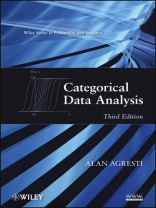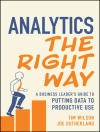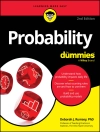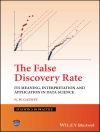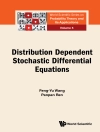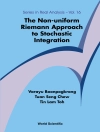Praise for the Second Edition
‘A must-have book for anyone expecting to do research and/or applications in categorical data analysis.’
—Statistics in Medicine
‘It is a total delight reading this book.’
—Pharmaceutical Research
‘If you do any analysis of categorical data, this is an essential desktop reference.’
—Technometrics
The use of statistical methods for analyzing categorical data has increased dramatically, particularly in the biomedical, social sciences, and financial industries. Responding to new developments, this book offers a comprehensive treatment of the most important methods for categorical data analysis.
Categorical Data Analysis, Third Edition summarizes the latest methods for univariate and correlated multivariate categorical responses. Readers will find a unified generalized linear models approach that connects logistic regression and Poisson and negative binomial loglinear models for discrete data with normal regression for continuous data. This edition also features:
- An emphasis on logistic and probit regression methods for binary, ordinal, and nominal responses for independent observations and for clustered data with marginal models and random effects models
- Two new chapters on alternative methods for binary response data, including smoothing and regularization methods, classification methods such as linear discriminant analysis and classification trees, and cluster analysis
- New sections introducing the Bayesian approach for methods in that chapter
- More than 100 analyses of data sets and over 600 exercises
- Notes at the end of each chapter that provide references to recent research and topics not covered in the text, linked to a bibliography of more than 1, 200 sources
- A supplementary website showing how to use R and SAS; for all examples in the text, with information also about SPSS and Stata and with exercise solutions
Categorical Data Analysis, Third Edition is an invaluable tool for statisticians and methodologists, such as biostatisticians and researchers in the social and behavioral sciences, medicine and public health, marketing, education, finance, biological and agricultural sciences, and industrial quality control.
Tabella dei contenuti
Preface xiii
1 Introduction: Distributions and Inference for Categorical Data 1
1.1 Categorical Response Data, 1
1.2 Distributions for Categorical Data, 5
1.3 Statistical Inference for Categorical Data, 8
1.4 Statistical Inference for Binomial Parameters, 13
1.5 Statistical Inference for Multinomial Parameters, 17
1.6 Bayesian Inference for Binomial and Multinomial Parameters, 22
Notes, 27
Exercises, 28
2 Describing Contingency Tables 37
2.1 Probability Structure for Contingency Tables, 37
2.2 Comparing Two Proportions, 43
2.3 Conditional Association in Stratified 2 × 2 Tables, 47
2.4 Measuring Association in I × J Tables, 54
Notes, 60
Exercises, 60
3 Inference for Two-Way Contingency Tables 69
3.1 Confidence Intervals for Association Parameters, 69
3.2 Testing Independence in Two-way Contingency Tables, 75
3.3 Following-up Chi-Squared Tests, 80
3.4 Two-Way Tables with Ordered Classifications, 86
3.5 Small-Sample Inference for Contingency Tables, 90
3.6 Bayesian Inference for Two-way Contingency Tables, 96
3.7 Extensions for Multiway Tables and Nontabulated Responses, 100
Notes, 101
Exercises, 103
4 Introduction to Generalized Linear Models 113
4.1 The Generalized Linear Model, 113
4.2 Generalized Linear Models for Binary Data, 117
4.3 Generalized Linear Models for Counts and Rates, 122
4.4 Moments and Likelihood for Generalized Linear Models, 130
4.5 Inference and Model Checking for Generalized Linear Models, 136
4.6 Fitting Generalized Linear Models, 143
4.7 Quasi-Likelihood and Generalized Linear Models, 149
Notes, 152
Exercises, 153
5 Logistic Regression 163
5.1 Interpreting Parameters in Logistic Regression, 163
5.2 Inference for Logistic Regression, 169
5.3 Logistic Models with Categorical Predictors, 175
5.4 Multiple Logistic Regression, 182
5.5 Fitting Logistic Regression Models, 192
Notes, 195
Exercises, 196
6 Building, Checking, and Applying Logistic Regression Models 207
6.1 Strategies in Model Selection, 207
6.2 Logistic Regression Diagnostics, 215
6.3 Summarizing the Predictive Power of a Model, 221
6.4 Mantel–Haenszel and Related Methods for Multiple 2 × 2 Tables, 225
6.5 Detecting and Dealing with Infinite Estimates, 233
6.6 Sample Size and Power Considerations, 237
Notes, 241
Exercises, 243
7 Alternative Modeling of Binary Response Data 251
7.1 Probit and Complementary Log–log Models, 251
7.2 Bayesian Inference for Binary Regression, 257
7.3 Conditional Logistic Regression, 265
7.4 Smoothing: Kernels, Penalized Likelihood, Generalized Additive Models, 270
7.5 Issues in Analyzing High-Dimensional Categorical Data, 278
Notes, 285
Exercises, 287
8 Models for Multinomial Responses 293
8.1 Nominal Responses: Baseline-Category Logit Models, 293
8.2 Ordinal Responses: Cumulative Logit Models, 301
8.3 Ordinal Responses: Alternative Models, 308
8.4 Testing Conditional Independence in I × J × K Tables, 314
8.5 Discrete-Choice Models, 320
8.6 Bayesian Modeling of Multinomial Responses, 323
Notes, 326
Exercises, 329
9 Loglinear Models for Contingency Tables 339
9.1 Loglinear Models for Two-way Tables, 339
9.2 Loglinear Models for Independence and Interaction in Three-way Tables, 342
9.3 Inference for Loglinear Models, 348
9.4 Loglinear Models for Higher Dimensions, 350
9.5 Loglinear—Logistic Model Connection, 353
9.6 Loglinear Model Fitting: Likelihood Equations and Asymptotic Distributions, 356
9.7 Loglinear Model Fitting: Iterative Methods and Their Application, 364
Notes, 368
Exercises, 369
10 Building and Extending Loglinear Models 377
10.1 Conditional Independence Graphs and Collapsibility, 377
10.2 Model Selection and Comparison, 380
10.3 Residuals for Detecting Cell-Specific Lack of Fit, 385
10.4 Modeling Ordinal Associations, 386
10.5 Generalized Loglinear and Association Models, Correlation Models, and Correspondence Analysis, 393
10.6 Empty Cells and Sparseness in Modeling Contingency Tables, 398
10.7 Bayesian Loglinear Modeling, 401
Notes, 404
Exercises, 407
11 Models for Matched Pairs 413
11.1 Comparing Dependent Proportions, 414
11.2 Conditional Logistic Regression for Binary Matched Pairs, 418
11.3 Marginal Models for Square Contingency Tables, 424
11.4 Symmetry, Quasi-Symmetry, and Quasi-Independence, 426
11.5 Measuring Agreement Between Observers, 432
11.6 Bradley–Terry Model for Paired Preferences, 436
11.7 Marginal Models and Quasi-Symmetry Models for Matched Sets, 439
Notes, 443
Exercises, 445
12 Clustered Categorical Data: Marginal and Transitional Models 455
12.1 Marginal Modeling: Maximum Likelihood Approach, 456
12.2 Marginal Modeling: Generalized Estimating Equations (GEEs) Approach, 462
12.3 Quasi-Likelihood and Its GEE Multivariate Extension: Details, 465
12.4 Transitional Models: Markov Chain and Time Series Models, 473
Notes, 478
Exercises, 479
13 Clustered Categorical Data: Random Effects Models 489
13.1 Random Effects Modeling of Clustered Categorical Data, 489
13.2 Binary Responses: Logistic-Normal Model, 494
13.3 Examples of Random Effects Models for Binary Data, 498
13.4 Random Effects Models for Multinomial Data, 511
13.5 Multilevel Modeling, 515
13.6 GLMM Fitting, Inference, and Prediction, 519
13.7 Bayesian Multivariate Categorical Modeling, 523
Notes, 525
Exercises, 527
14 Other Mixture Models for Discrete Data 535
14.1 Latent Class Models, 535
14.2 Nonparametric Random Effects Models, 542
14.3 Beta-Binomial Models, 548
14.4 Negative Binomial Regression, 552
14.5 Poisson Regression with Random Effects, 555
Notes, 557
Exercises, 558
15 Non-Model-Based Classification and Clustering 565
15.1 Classification: Linear Discriminant Analysis, 565
15.2 Classification: Tree-Structured Prediction, 570
15.3 Cluster Analysis for Categorical Data, 576
Notes, 581
Exercises, 582
16 Large- and Small-Sample Theory for Multinomial Models 587
16.1 Delta Method, 587
16.2 Asymptotic Distributions of Estimators of Model Parameters and Cell Probabilities, 592
16.3 Asymptotic Distributions of Residuals and Goodness-of-fit Statistics, 594
16.4 Asymptotic Distributions for Logit/Loglinear Models, 599
16.5 Small-Sample Significance Tests for Contingency Tables, 601
16.6 Small-Sample Confidence Intervals for Categorical Data, 603
16.7 Alternative Estimation Theory for Parametric Models, 610
Notes, 615
Exercises, 616
17 Historical Tour of Categorical Data Analysis 623
17.1 Pearson–Yule Association Controversy, 623
17.2 R. A. Fisher’s Contributions, 625
17.3 Logistic Regression, 627
17.4 Multiway Contingency Tables and Loglinear Models, 629
17.5 Bayesian Methods for Categorical Data, 633
17.6 A Look Forward, and Backward, 634
Appendix A Statistical Software for Categorical Data Analysis 637
Appendix B Chi-Squared Distribution Values 641
References 643
Author Index 689
Example Index 701
Subject Index 705
Appendix C Software Details for Text Examples (text website)
Circa l’autore
ALAN AGRESTI is Distinguished Professor Emeritus in the Department of Statistics at the University of Florida. He has presented short courses on categorical data methods in thirty countries. He is the author of five other books, including An Introduction to Categorical Data Analysis, Second Edition and Analysis of Ordinal Categorical Data, Second Edition, both published by Wiley.
